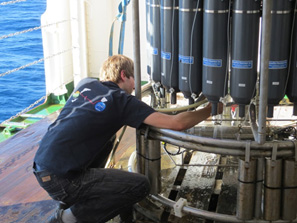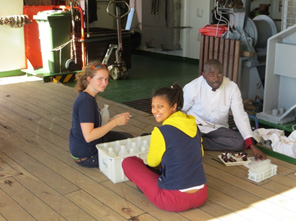The morning brought fair weather and calmer seas. There was business as usual, with breakfast occurring at 7:30am, and although the shift in time meant that everyone had gotten an hour less to sleep, most of participants made it more or less on time! Morning lectures on oceanic and atmospheric chemistry followed. Lectures have – for the foreseeable future – been moved from the seasickness-inducing windowless conference room to the more pleasant mess hall.
Continuing our course northeast, we had finally reached international waters the previous evening, and were therefore able to take the first CTD cast of the cruise today. At noon in the sunshine, the rosette with two dozen Niskin bottles was lowered to a depth of more than 4000m. As the CTD descended, the primary focus of all involved was on which colour should represent which parameter. Pink for oxygen and blue for salinity? Or green for salinity and red for potential temperature?
After about 3 and a half hours, the rosette arose from its depths and scientists rushed towards the bottles to access their water samples. An order of samples had been established, with insoluble gases taking priority, and nutrients and DNA bringing up the rear. Other analyses included CDOM, halocarbons, isoprene, pigments and DMS. Overall, the afternoon’s investigations were successful, and we hope for much of the same tomorrow. Since we will be passing close to Madagascar, some of the participants are taking out their binoculars in the expectation of spotting some lemurs!
(Dennis Booge and Robyn Granger, SO234-2 students)

